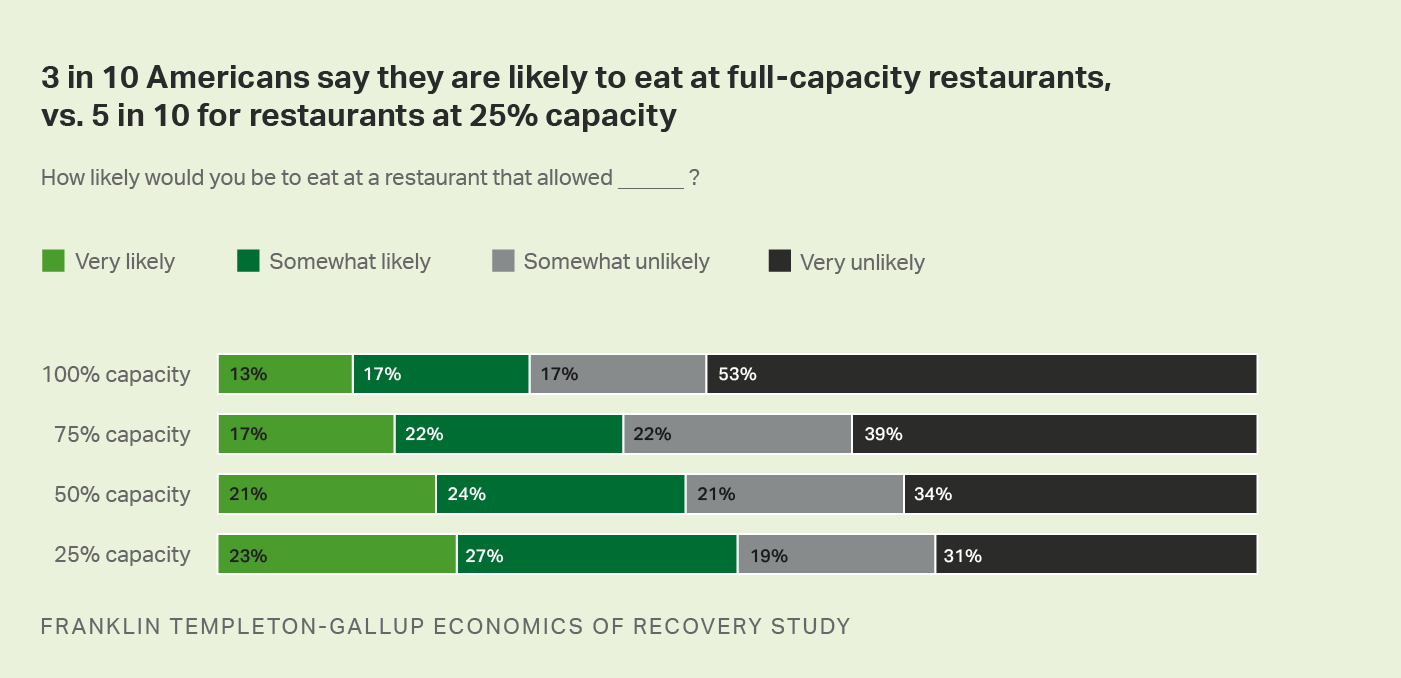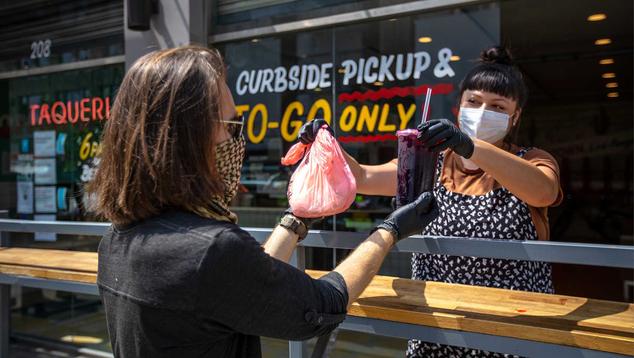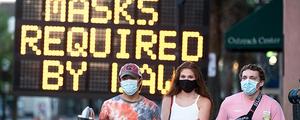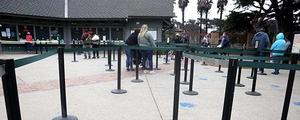Story Highlights
- Republicans, Americans with kids among the most likely to eat out
- Reduced seating capacity raises likelihood people will visit restaurants
Editor's Note: The research below was conducted in partnership between Franklin Templeton and Gallup.
WASHINGTON, D.C. -- Across the U.S., businesses are balancing the need to resume normal operations with the need to ensure not only that their customers are safe, but that they feel safe. In order to find the right timing and strategies for reopening, businesses need ways to gauge customers' sense of security under a variety of conditions and with different precautions in place. For example, Americans' willingness to eat indoors at restaurants and travel by plane are barometers of their confidence about engaging in economic activities that require them to be in proximity with others in closed quarters for sustained periods of time.
In a survey conducted July 2-14, 12% of Americans said they or someone in their household had dined indoors at a restaurant in the past 24 hours, while 9% said they had dined at a restaurant seated outdoors during that time. These results are based on more than 10,000 web-based surveys as part of the Franklin Templeton-Gallup Economics of Recovery study.
| Dined at a restaurant, seated indoors | Dined at a restaurant, seated outdoors | ||||||||||||||||||||||||||||||||||||||||||||||||||||||||||||||||||||||||||||||||||||||||||||||||||
|---|---|---|---|---|---|---|---|---|---|---|---|---|---|---|---|---|---|---|---|---|---|---|---|---|---|---|---|---|---|---|---|---|---|---|---|---|---|---|---|---|---|---|---|---|---|---|---|---|---|---|---|---|---|---|---|---|---|---|---|---|---|---|---|---|---|---|---|---|---|---|---|---|---|---|---|---|---|---|---|---|---|---|---|---|---|---|---|---|---|---|---|---|---|---|---|---|---|---|---|
| % | % | ||||||||||||||||||||||||||||||||||||||||||||||||||||||||||||||||||||||||||||||||||||||||||||||||||
| All Americans | 12 | 9 | |||||||||||||||||||||||||||||||||||||||||||||||||||||||||||||||||||||||||||||||||||||||||||||||||
| Age 18-34 | 17 | 16 | |||||||||||||||||||||||||||||||||||||||||||||||||||||||||||||||||||||||||||||||||||||||||||||||||
| Age 35-54 | 12 | 9 | |||||||||||||||||||||||||||||||||||||||||||||||||||||||||||||||||||||||||||||||||||||||||||||||||
| Age 55+ | 8 | 4 | |||||||||||||||||||||||||||||||||||||||||||||||||||||||||||||||||||||||||||||||||||||||||||||||||
| No children in household | 9 | 6 | |||||||||||||||||||||||||||||||||||||||||||||||||||||||||||||||||||||||||||||||||||||||||||||||||
| Children in household | 19 | 14 | |||||||||||||||||||||||||||||||||||||||||||||||||||||||||||||||||||||||||||||||||||||||||||||||||
| Republican | 17 | 11 | |||||||||||||||||||||||||||||||||||||||||||||||||||||||||||||||||||||||||||||||||||||||||||||||||
| Democrat | 10 | 9 | |||||||||||||||||||||||||||||||||||||||||||||||||||||||||||||||||||||||||||||||||||||||||||||||||
| Independent | 9 | 7 | |||||||||||||||||||||||||||||||||||||||||||||||||||||||||||||||||||||||||||||||||||||||||||||||||
| Franklin Templeton-Gallup Economics of Recovery Study | |||||||||||||||||||||||||||||||||||||||||||||||||||||||||||||||||||||||||||||||||||||||||||||||||||
Americans aged 55 and older are the least likely age group to say they have eaten at a restaurant in the past 24 hours. Responses also vary by political affiliation, with Republicans (17%) significantly more likely than Democrats (10%) or Independents (9%) to have dined indoors at a restaurant. Republicans and Democrats are similarly likely to have eaten outdoors at a restaurant in the past 24 hours.
The results also suggest family life has a bearing on Americans' tendency to venture back to restaurants. Those who have children in their household, are more likely to have dined at a restaurant, indoors or outdoors, in the past 24 hours. This finding likely reflects the social aspect of eating out; people are more likely to return to restaurant dining if they have others in their social "bubble" to go with. These differences remain even within other demographic categories, such as party affiliation; for example, 18% of Democrats with children have dined indoors at a restaurant in the past 24 hours, vs. 7% of Democrats without children.
Willingness to Eat at Restaurants Rises With Reduced Seating Capacity
One of the most common precautions restaurants have taken, often in compliance with local public health orders, is to limit their seating capacity to ensure there is enough space indoors for customers to practice social distancing with diners at other tables. CDC guidelines put restaurants that reduce seating capacity to allow tables to be placed six feet apart in a lower risk category than those that do not.
The survey tested the extent to which reduced seating capacity increases people's confidence that it is safe to eat indoors at restaurants. Respondents were randomly assigned to four treatment groups to test their willingness to eat at restaurants that allow one of four capacity levels: 25%, 50%, 75% or 100%. Overall, three in 10 of those who were asked about restaurants that allow 100% capacity said they would be very or somewhat likely to eat there. The figure rises gradually to five in 10 among those who were asked the same question about restaurants that allow 25% capacity.

Stacked bar graph. Americans willingness to eat a restaurant by the percentage of capacity of patrons the restaurant is allowed. 13 percent of Americans are very likely to eat at a restaurant that it is allowed 100 percent capacity 17 percent at one permitted 75 percent capacity 21 percent at a one that allowed 50 percent capacity and 23 percent at an establishment with 25 percent capacity.
As with restaurant dining overall, these results vary significantly among certain demographic groups, particularly partisanship and family status. As a result, Democrats are about as willing to eat indoors at a restaurant at 25% capacity as Republicans are at a restaurant at full capacity (both 41%). Similarly, Americans without children are about as likely to eat in at a restaurant at 25% capacity as those with children are to eat in at a restaurant at 75% capacity (both close to half).
Implications
Food preparation and service is the second-most-common occupation in the U.S., while waiting tables is the eighth-most-common, according to the Bureau for Labor Statistics. Using BLS data, Gallup's Principal Economist Jonathan Rothwell notes that unemployment rose more sharply among food preparation and service workers between February (4%) and July (20%) than among those in almost any other industry.
Many restaurant-industry workers live paycheck-to-paycheck, with little margin for spending time out of work to wait out the crisis. And many restaurant owners who were forced to close their doors or severely restrict their services have still had to pay rent and other operating expenses. Thus, in the restaurant industry alone, the pandemic has disrupted a critical source of employment for lower-skilled workers and threatened the existence of many small, local businesses.
In creating strategies that help them manage strained resources and increase sales while accounting for customer safety, restaurants need reliable information on Americans' willingness to return to their establishments -- and which are already returning -- in order to cater to their needs. Understanding the perceived risks associated with eating out, and the extent to which precautions like limited capacity can alter those perceptions, will be critical for the restaurant industry's recovery in the coming months.
To receive ongoing updates on the Franklin Templeton-Gallup Economics of Recovery Study's findings, please sign up here. To read the project announcement press release, please visit this page.
If you are a member of the media who would like to learn more about the project's findings and release schedule, please reach out to Riley_Brands@gallup.com.




